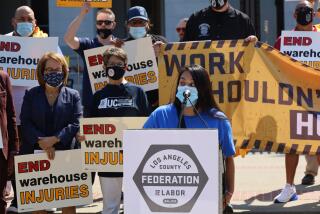Too Many Lawyers, Too Few Results
For Carl A. Anderson, the more things change, the more they stay the same. His story typifies America’s asbestos litigation disgrace: lots of action, but little movement.
Anderson, 79, has already waited more than seven years for compensation for his advanced asbestosis, a lung disease caused by working around asbestos insulation products at the Long Beach Naval Shipyard for 30 years. Anderson is so short of breath now that he cannot walk more than a block or two. Even though the products’ manufacturers conceded that asbestos caused his disease, a Los Angeles Superior Court jury in 1986 said that Anderson could not collect because the defendants had not known asbestos was dangerous.
Last week the California Supreme Court agreed but told Anderson he is entitled to another trial, if he wants to wait. The court said that the trial judge erred in later overruling the jury’s finding with respect to so-called “state-of-the-art” evidence--what manufacturers knew and when.
Anderson represents lots of asbestos victims nationwide. Asbestos litigation has cost as much as $10 billion over the last 20 years, with only a third trickling down from lawyers and experts to claimants such as Anderson. Lots of trials and appeals. Lots of old, sick men.
About 60,000 asbestos injury claims have been resolved. But more than 130,000 remain and about 1,500 new cases are being filed each month with no end in sight. Several asbestos manufacturers declared bankruptcy when they totaled the pending and projected claims and their potential legal expenses. Others are delaying or resisting, only paying lawyers to churn cases and appeal. For too many Carl Andersons, compensation is still a distant dream.
But some federal judges are now seriously exploring new ways of grouping cases to finally end this legal war of attrition. Once grouped, cases tend to move more quickly to trial or settlement than those handled one at a time. And grouping is often the only way to pressure defendants to pay claimants. Last week, a federal panel heard arguments about consolidating all federal asbestos cases. State and federal judges in Maryland, Mississippi and Texas are experimenting with group trials with as many as 9,000 cases.
That’s one way to deal with the madness. Lawyers and judges need to agree on a few of the many available options for grouping cases, collect all state and federal claims and settle or try them before panels of judges.
To expedite this process, Congress could declare that asbestos exposure is de facto proof of injury, as it did for Vietnam veterans exposed to Agent Orange, and allow claimants to qualify for care through Medicare or the Social Security disability system.
Meanwhile, Carl Anderson hopes he lives to see his next day in court, and all the inevitable appeals to follow.
More to Read
Inside the business of entertainment
The Wide Shot brings you news, analysis and insights on everything from streaming wars to production — and what it all means for the future.
You may occasionally receive promotional content from the Los Angeles Times.










